TEAM UP for a Sustainable World:A Ride on the Next-generation Public Transit System, "KnowRoute"
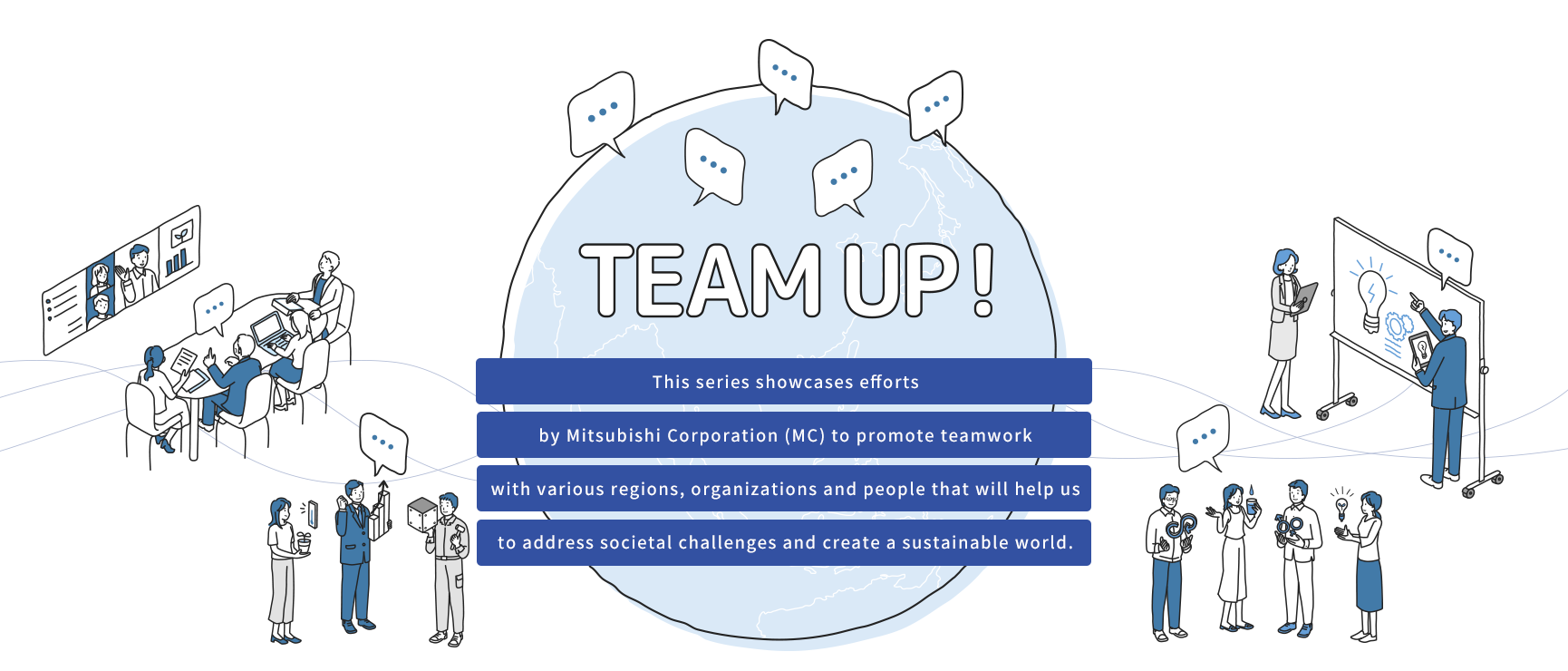
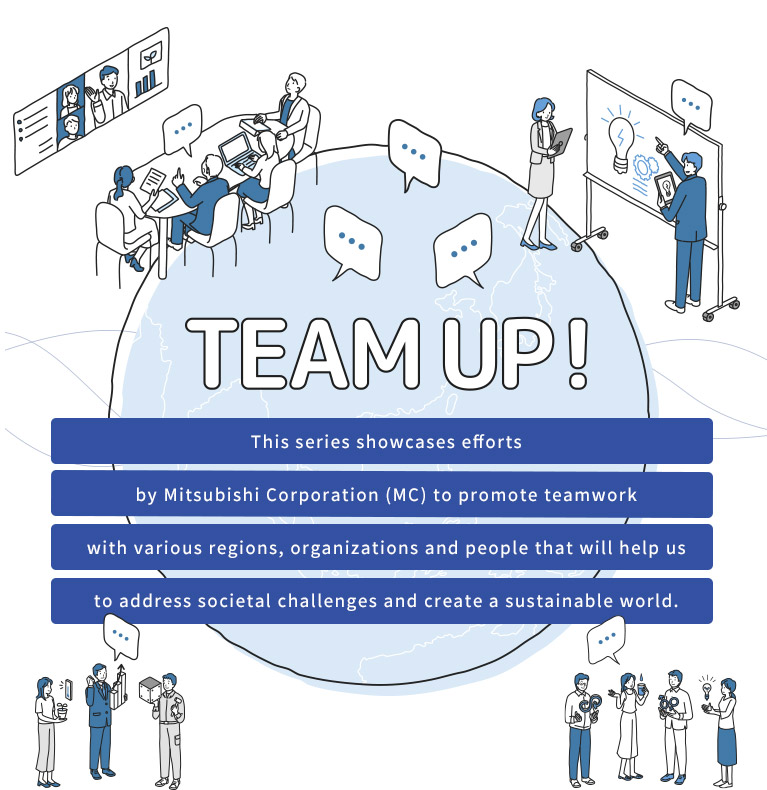
A Ride on the Next-generation Public Transit System, "KnowRoute" TEAM UP for a Sustainable World
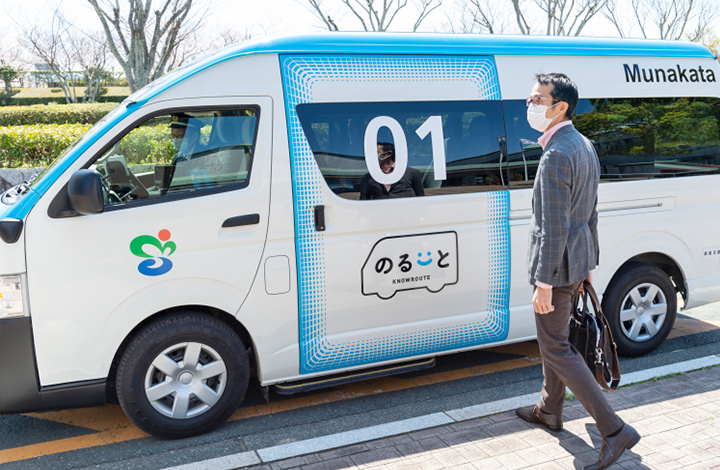
The AI-driven On-demand Bus Service "KnowRoute" (1)
Munakata City is in Fukuoka Prefecture, which is located in southern Japan on the island of Kyushu and is known as a bedtown. In Munakata City, an entirely new form of public local transportation has been lately gaining popularity, which is called as "KnowRoute" and is an on-demand bus service that is designed to take advantage of artificial technology (AI) to dispatch its buses solely to the desired pick-up and drop-off points of its passengers and at the times of their choosing. But how does it actually work? In early April 2022, GLOBE+ Editor in Chief Takashi Horiuchi visited Munakata City and saw for himself. Why do we need new forms of public transportation, and why now? To find out, Horiuchi spoke with employees of Next Mobility Co., Ltd. (Next Mobility), a joint venture between MC and Nishi-Nippon Railroad Co., Ltd (Nishitetsu).
Combining the advantages of Taxis and Buses
The "KnowRoute" system has neither any preset time tables nor any fixed routes. Munakata City, where its trial runs are taking place, is a roughly 30-kilometer away from and in the middle of the cities of Fukuoka and Kita-Kyushu. The "Hinosato District" of the city, where the "Hinosato Danchi" residential complex is located, has been developed to stimulate a period of high economic growth. The complex is among the largest of its kind in Kita-Kyushu, covering an area of 217 hectares.
In order to use the "KnowRoute" system, passengers must first book a ride, either through the system's smartphone app or by phone. Once they have registered themselves as users of the system, those making the bookings simply have to choose their desired pick-up and drop-off points, when they wish to be picked up, and how many passengers will be in their parties.
"The 'KnowRoute' app has a simple user interface, so it is very easy to make bookings, even for first-time users of the system," says Horiuchi.
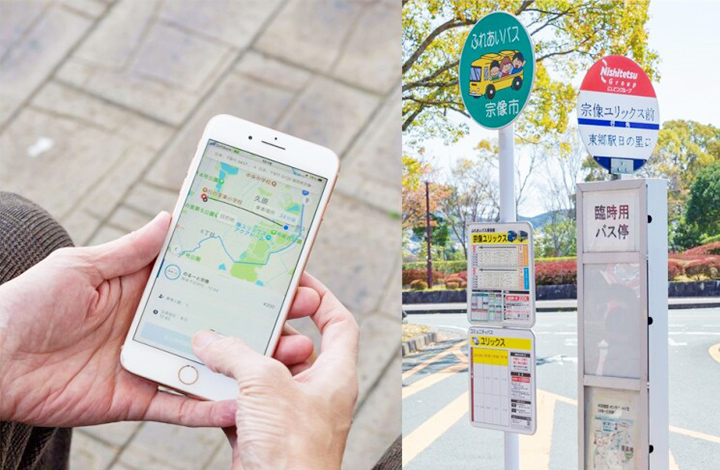
The system employs pick-up and drop-off spots called "Meeting Points," of which there are currently 65 located throughout the trial-run area. On the day he tested the system, Horiuchi booked a roughly one-kilometer ride to Hinosato Danchi from a mixed-use development complex that comprises an event hall, public library and other facilities. At precisely 12:40 pm (his requested pick-up time), a blue and white, eight-passenger bus emblazoned with the "KnowRoute" logo rolled up to meet him.
To pay for their rides, passengers first inform the bus drivers of the last four digits of the phone numbers that they used to register on the system. In Horiuchi's case, the one-way fare to Hinosato Danchi was 200 yen. Payments can be made with IC commuter cards, registered credit cards or cash.
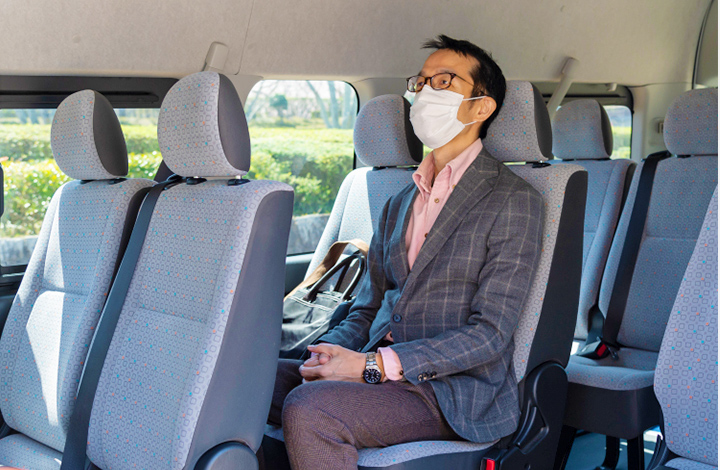
"The bus arrived almost exactly on time and the ride to my destination was very smooth," recalls Horiuchi. "The system is very well thought out, as it combines the convenience of a taxi with the affordability of a city bus."
Although at present there are only two "KnowRoute" buses that regularly service Hinosato Danchi, the buses seems to be catching on.
"When I walked around the residential complex, I saw the buses quite frequently, and I got the impression that they are being well used by the locals," says Horiuchi.
Incidentally, the name "KnowRoute" is a bilingual play on words. In the local Fukuoka dialect, noruto means noru? (lit. "Are you getting on?" or "Do you need a lift?") but the pronunciation is similar to the words "know route" in English. The system's Japanese name actually includes a hyphen between the first two characters (noru) and the last (to), and the cute logo that replaces the hyphen with a little smiley face is helping the service to catch on.
Why the Focus on Mobility Services?
"KnowRoute" service is being developed by Next Mobility, a joint-venture company launched in 2019 by MC and Nishitetsu.
MC has been engaged in automotive businesses for many decades, both here in Japan and around the world, so why is it now developing these kinds of new mobility services? Helping to shed light on the auto-sector reforms that are behind this decision by MC is Takehiro Fujioka, who was part of the company's team that first conceived the "KnowRoute" model. Fujioka currently serves as Next Mobility's Executive Vice President and Corporate Strategy Officer (CSO).
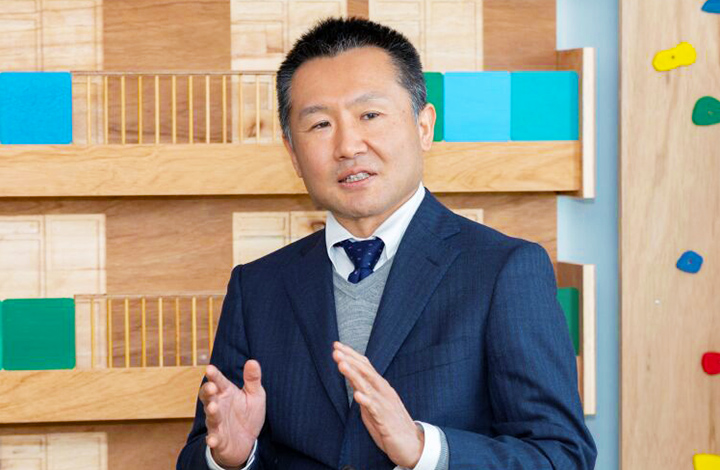
"Today's automotive industries are being revolutionized by the rapid global spread of CASE related products and services," says Fujioka. CASE, which stands for "Connected, Autonomous, Shared Services, & Electric" encompasses a variety of initiatives, which as Fujioka explains are being fueled primarily by growth in the electric vehicle (EV) market and changing values with respect to our personal use of automobiles.
"More and more people are electing to share cars rather than own them, and the business of selling them is obviously having to evolve in step with that," he says. "There was a sense of urgency at MC that prompted us to look at new models in mobility, because we realized that unless we changed our approach to business conception, we were going to be left behind."
In the spring of 2017, talks began at MC to indentify new business opportunities in consumer-oriented mobility services. Through meetings with major bus companies across Japan, Fujioka and his fellow project-team members soon realized that certain problems were common throughout the industry.
"One of the issues that all of the bus-service providers are having to contend with is expansition of the bus routes which continue to lose money," says Fujioka. "It is particularly difficult to keep unprofitable routes going in the more rural parts of Japan, where passenger numbers are declining, so the people who live in those areas are quickly losing their means of getting around. The ones most affected are elderly citizens who have voluntarily given up their drivers licenses due to old age."
"Another problem has been driver shortages, particularly those large bus drivers who have Large type 2 licences of buses. The ones we have now are aging, and 20 - 30% of them will be retiring in the next five to ten years. This is a grave situation, but at MC we realized that if we could address it, then we would not only be helping to solve problems facing Japanese society, but also creating a new business opportunity."
Multi-entity thoughts on regional trasit issues
Hirofumi Matsumura is a Nishitetsu employee who is currently on secondment at Next Mobility. He spoke to us about both of these problems, which Nishitetsu has been leveraging its strengths to help solve. His employer is one of Japan's largest private railroad companies, boasting a huge network of lines and a history dating back more than 110 years.
"For folks in Japan's rural communities, buses are essential to their quality of life, and we have a corporate responsibility to help preserve that," he says. "Unfortunately, Japan has seen both its population and birthrate decline in recent years, which has made things tough for many businesses, Nishitetsu included. Shrinking bus fleets and routes are issues that I was having to contend with in my own day-to-day work since even before we joined forces with MC."

Just when Matsumura began thinking of ways to revive Nishitetsu's bus operations, he was contacted by the sogo shosha.
"They called and asked me if Nishitetsu was interested in working with them on a new type of mobility service, something that had never been seen before in Japan and that could help solve problems in its rural communities," says Matsumura. Sharing that same vision, Nishitetsu accepted the offer to team up with MC on what would eventually become Next Mobility.
The new partners began by examining various future scenarios in Japan's bus industry, which included discussions on autonomous buses, securing more drivers, and other ways to solve the problems of unprofitable routes and driver shortages.
"We had a number of project ideas, but in the spring of 2018 we narrowed them down to an on-demand bus service," recalls Fujioka. "Our reasoning was that such a service could solve both problems, plus the systems needed to make it possible were pretty much proven technologies already."
Superior Algorithms designated To Create a Peak Passenger Experience
Once that decision was made, things really started to gain momentum. In April 2018, MC and Nishitetsu assembled a joint project team, which began working on all facets of the business, from assessing local traffic conditions and designing operations, to formulating a business plan and procuring the buses and systems equipment. The following spring, MC and Nishitetsu launched Next Mobility to take over the business.
In April 2019, just one year after the joint project team was assembled, trial runs of the "KnowRoute" service got underway in Fukuoka's Island City.
"The fact that Nishitetsu, the local authorities and MC all did their utmost to make the service possible is precisely why it came to fruition," says Fujioka.
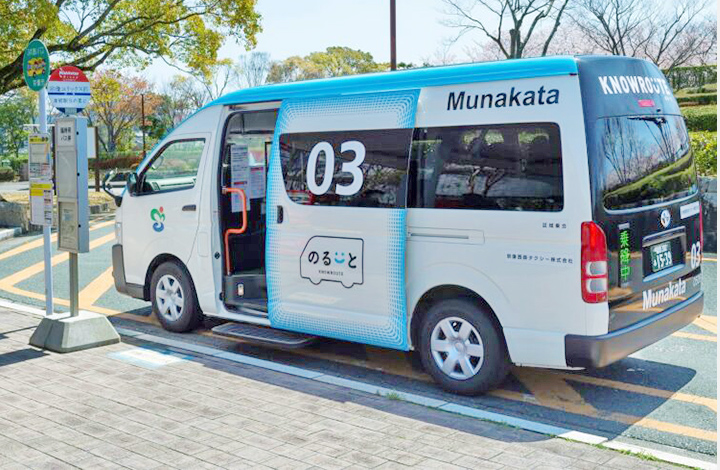
"KnowRoute" is a very user-friendly service, and the key to that convenience is its AI-powered bus dispatching system, as explained by another employee on secondment at Next Mobility, MC's Kenichi Akimoto.
"When bookings come in from different locations, the AI automatically calculates the most efficient route to pick everyone up and drop them off," he says. "Traditional dispatching systems rely on human operators to take calls from passengers. The operators have to take time to decide what the best order is for pick ups and drop offs and then inform the drivers, but our system computes all of this automatically and immediately. The AI is essential to ensuring that we get enough passengers to keep the business feasible."
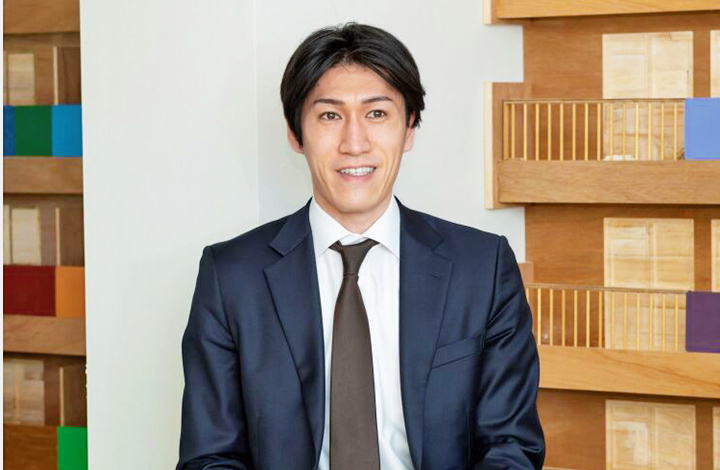
After comparing the dispatching systems of more than ten vendors both inside and outside Japan, Next Mobility settled on one developed by the Canadian startup company, Spare Labs Inc.
"In addition to having designed a superior algorithm for efficient bus operations, Spare Labs offered a system capable of flexibly adapting to different regional characteristics," says Akimoto. "For example, if certain areas tend to get busy in the evening, then the AI will learn, adapt and choose routes that avoid the congestion during those hours. When we witnessed for ourselves just how sophisticated Spare Labs' system is, we decided that they would be the best choice for a long-term partnership."
After Two Years of Trial Operations, What Lies Ahead for "KnowRoute?"
The "KnowRoute" bus trials in Munakata City are scheduled to run for approximately two years, concluding in March 2023. Some may wonder why passengers are required to pay even during the trial period, but as Fujioka explains, there are good reasons for this.
"If the service were free during the trials, or if they were only run for a short period, then we wouldn't be able to accurately determine whether or not people like the service and want it to continue," he says. "Be conducting these trial runs over a two-year period not for free, we'll be able to closely monitor how well the service is accepted by society and get some ideas on how we can make it even better."
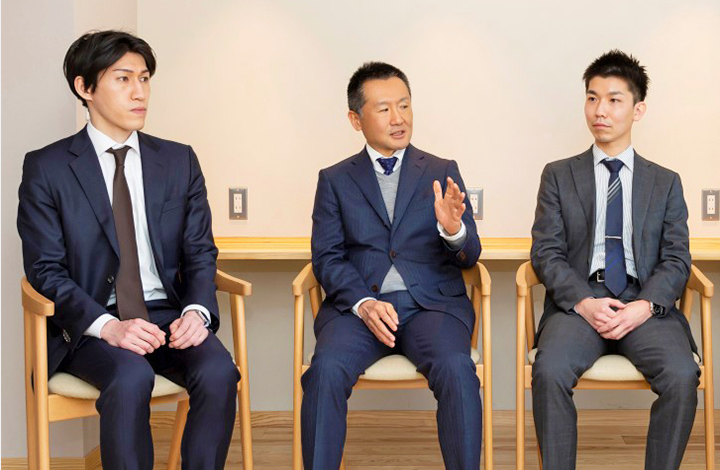
Having now entered year two of its trial period, "KnowRoute" is gradually taking root in Munakata City. Passengers have been very pleased with the service thus far, but according to Akimoto, some problems have also come to light.
"The issues that have come up have convinced us that there is a lot more room for this system to evolve and improve," he says.
With its sights set on achieving sustainable, convenient and sophisticated mobility services, MC remains committed to taking on new challenges.
- * Volume 2 of this series will feature a roundtable discussion between Next Mobility employees and the Fukuoka and Munakata city authorities.
- * The interviews conducted for the purpose of this article were carried out in accordance with pandemic-related measures. Masks were only removed for photographs.
- The AI-driven On-demand Bus Service "KnowRoute" (1)
- The AI-driven On-demand Bus Service "KnowRoute" (2)
- The AI-driven On-demand Bus Service "KnowRoute" (3)

